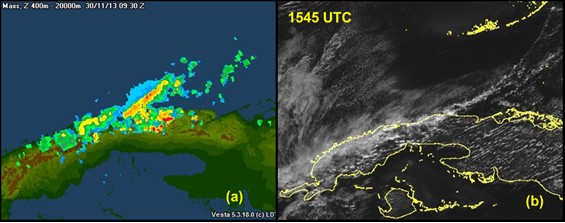Study of the intense rainfall that occurred in Havana province on November 29 and 30, 2013. Synoptic and mesoscale characteristics
Main Article Content
Abstract
Heavy rains are a dangerous meteorological phenomenon that frequently affects Cuba at any time of year. This phenomenon is due to the combination of synoptic and mesoscale systems, which sometimes favor the rapid development of extreme hydrometeorological events. The Forecast Center of the Institute of Meteorology has been monitoring complex situations over the province of Havana during the dry season. These situations have had one common characteristic: shallow convective cloud cover. The case of November 29 and 30, 2013, was analyzed for this study. The methodology used is based on the analysis of the evolution of synoptic systems at the surface and in the upper air (850, 700, 500 and 200 hPa), relative humidity in the low and middle layers, wind direction and strength at 925 hPa and the flow at 1000 hPa; in addition to thermodynamic indices, radar observations and satellite images; these were used to characterize the prevailing conditions at the synoptic and mesoscale scales. The effectiveness of the WRF (Weather Research and Forecasting) numerical prediction model in simulating the persistence and amount of rainfall was also evaluated. The formation of a moderate convection line with a nearly stationary structure and the existence of centroid echoes of maximum reflectivity in the lower cloud layer are determined, fundamental elements for the effectiveness of precipitation.
Downloads
Article Details

This work is licensed under a Creative Commons Attribution-NonCommercial 4.0 International License.
Those authors who have publications with this journal accept the following terms of the License Attribution-NonCommercial 4.0 International (CC BY-NC 4.0):
You are free to:
- Share — copy and redistribute the material in any medium or format
- Adapt — remix, transform, and build upon the material
The licensor cannot revoke these freedoms as long as you follow the license terms.
Under the following terms:
- Attribution — You must give appropriate credit, provide a link to the license, and indicate if changes were made. You may do so in any reasonable manner, but not in any way that suggests the licensor endorses you or your use.
- NonCommercial — You may not use the material for commercial purposes.
- No additional restrictions — You may not apply legal terms or technological measures that legally restrict others from doing anything the license permits.
The journal is not responsible for the opinions and concepts expressed in the works, they are the sole responsibility of the authors. The Editor, with the assistance of the Editorial Committee, reserves the right to suggest or request advisable or necessary modifications. They are accepted to publish original scientific papers, research results of interest that have not been published or sent to another journal for the same purpose.
The mention of trademarks of equipment, instruments or specific materials is for identification purposes, and there is no promotional commitment in relation to them, neither by the authors nor by the publisher.
References
Caracena, F. et al. (1979): “Mesoanalysis of the Big Thompson storm. Monthly WeatherReview, pp 1-17, 107 pp.
Fernández, A. J. y Y. Díaz (2005): “Catálogo de los Procesos Sinópticos del Archipiélago Cubano en el período 1979-1993” Editorial Academia, 167 pp.
González, P. C. (1984): “Algunas características de los sistemas frontales que produjeron precipitaciones por más de 100 mm en 24 horas”, en Primer Seminario Taller de Desastres Naturales, UNDRO.
González, M. I. (2014): “Lluvia intensa en el período poco lluvioso desde Ciego de Ávila hasta Guantánamo”, Tesis en opción al título de Licenciado en Meteorología, La Habana, 75. pp.
Lecha, L y A. Fernández (1982): “Relación entre la distribución de las precipitaciones en la región central de Cuba y el campo de viento a mesoescala y escala sinóptica”. Resumen de los trabajos de la V Jornada Científica del INSMET de la A.C.C. La Habana, 19pp.
Maddox, R. A., C. F. Chappell, and L. R. Hoxit, 1979: Synoptic and mesoalpha scaleaspects of flash flood events. Bull. Amer. Meteor. Soc., 60, 115–123.
Mursulí, A. (2006): “Comportamiento de los días con lluvias intensas en la provincia de Ciego de Ávila en el período lluvioso y su relación con los Procesos Sinópticos Objetivos”. Tesis para optar por el grado académico de Master en Ciencias Meteorológicas, Ciudad de La Habana, 2006, 120 pp.
Quintero P. D y D.M. Suárez (2016): “Estudio de la situación de precipitaciones intensas de los dis 22 y 23 de octubre de 2015 en Canarias” Agencia Estatal de Meteorología (AEMET). Madrid.
Orbe, G. (2009): “Sistema de reconocimiento de patrones de eventos de lluvias intensas en la mitad occidental de Cuba”. Tesis presentada en opción al grado deDoctor en ciencias meteorológicas. La Habana, 133 pp.
Rubiera, J. y A, Caymares (1998): Eventos del tiempo severo inducidos por el ENSO en la temporada invernal cubana. 11 pp.
Sempere, D. et al. (2000): “El episodio pluviométrico del 10 de Junio en Cataluña.Un primer estudio hidrometeorológico”, Ingeniería del Agua, Vol. 7, No.2 Junio, pp.105-115.

